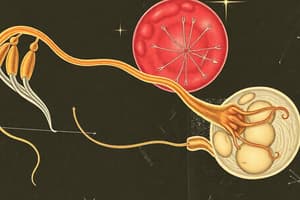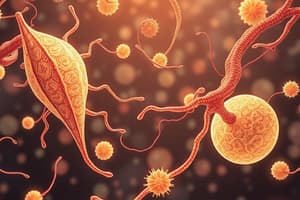Podcast
Questions and Answers
During which process do haploid spermatids develop into mature spermatozoa?
During which process do haploid spermatids develop into mature spermatozoa?
- Spermiogenesis (correct)
- Meiosis II
- Meiosis I
- Mitosis
What is the outcome of meiosis II?
What is the outcome of meiosis II?
- Two haploid cells
- One diploid cell
- Four diploid cells
- Four haploid cells (correct)
What is the purpose of crossing over during prophase I of meiosis?
What is the purpose of crossing over during prophase I of meiosis?
- To align chromosomes
- To separate sister chromatids
- To exchange genetic material (correct)
- To condense chromosomes
What occurs during anaphase I of meiosis?
What occurs during anaphase I of meiosis?
What is the function of the epididymis in spermatogenesis?
What is the function of the epididymis in spermatogenesis?
What is the end result of spermatogenesis?
What is the end result of spermatogenesis?
What is the primary factor determining the ovarian reserve?
What is the primary factor determining the ovarian reserve?
Which stage of folliculogenesis involves the formation of antral follicles?
Which stage of folliculogenesis involves the formation of antral follicles?
What is the final stage of oocyte development?
What is the final stage of oocyte development?
What is the result of meiosis I in oogenesis?
What is the result of meiosis I in oogenesis?
Which factor can affect ovarian reserve?
Which factor can affect ovarian reserve?
What occurs during meiosis II in oogenesis?
What occurs during meiosis II in oogenesis?
Flashcards are hidden until you start studying
Study Notes
Spermatogenesis
Spermiogenesis
- Process by which immature spermatozoa (spermatids) develop into mature spermatozoa
- Occurs in the epididymis
- Involves:
- Removal of excess cytoplasm
- Formation of the acrosome
- Development of the tail and flagellum
- Condensation of the chromatin
Spermatozoa Development
- Spermatogonia (diploid stem cells) undergo mitosis to form primary spermatocytes
- Primary spermatocytes undergo meiosis I to form secondary spermatocytes
- Secondary spermatocytes undergo meiosis II to form haploid spermatids
- Spermatids undergo spermiogenesis to form mature spermatozoa
Meiosis
- Process by which diploid cells (spermatogonia) give rise to haploid cells (spermatozoa)
- Consists of two successive cell divisions: meiosis I and meiosis II
- Meiosis I:
- Prophase I: homologous chromosomes pair up and exchange genetic material (crossing over)
- Metaphase I: paired chromosomes align at the center of the cell
- Anaphase I: paired chromosomes separate
- Telophase I: nuclear envelope reforms
- Meiosis II:
- Prophase II: chromosomes condense and become visible
- Metaphase II: chromosomes align at the center of the cell
- Anaphase II: sister chromatids separate
- Telophase II: nuclear envelope reforms, resulting in four haploid cells
Spermatogenesis
- Process by which immature cells develop into mature spermatozoa
Spermiogenesis
- Occurs in the epididymis
- Involves removal of excess cytoplasm
- Involves formation of the acrosome
- Involves development of the tail and flagellum
- Involves condensation of the chromatin
- Results in mature spermatozoa
Spermatozoa Development
- Spermatogonia are diploid stem cells
- Spermatogonia undergo mitosis to form primary spermatocytes
- Primary spermatocytes undergo meiosis I to form secondary spermatocytes
- Secondary spermatocytes undergo meiosis II to form haploid spermatids
- Spermatids undergo spermiogenesis to form mature spermatozoa
Meiosis
- Process by which diploid cells give rise to haploid cells
- Consists of two successive cell divisions: meiosis I and meiosis II
- Meiosis I involves:
- Homologous chromosomes pairing up and exchanging genetic material (crossing over)
- Paired chromosomes aligning at the center of the cell
- Paired chromosomes separating
- Nuclear envelope reforming
- Meiosis II involves:
- Chromosomes condensing and becoming visible
- Chromosomes aligning at the center of the cell
- Sister chromatids separating
- Nuclear envelope reforming, resulting in four haploid cells
Oogenesis
Folliculogenesis
- Follicles develop in the ovaries through a process involving growth and maturation from primordial to preovulatory follicles
- Five stages of folliculogenesis: primordial follicle formation, activation of primordial follicles, primary follicle formation, secondary follicle formation, and antral follicle formation
Oocyte Development
- Oocyte development occurs in three stages: oogonia proliferation and differentiation, oocyte growth and maturation, and oocyte maturation and ovulation
- Oocyte growth and maturation involves an increase in oocyte size and acquisition of meiotic competence
- Oocyte maturation involves progression from prophase I to metaphase II of meiosis
Ovarian Reserve
- Ovarian reserve refers to the number and quality of oocytes available in the ovaries
- Determined by the number of primordial follicles present at birth and the rate of follicular atresia
- Ovarian reserve declines with age, leading to decreased fertility
- Factors affecting ovarian reserve: age, genetics, environmental toxins, and medical history
Meiosis
- Meiosis is a specialized form of cell division that occurs in oogenesis
- Involves two successive cell divisions (meiosis I and meiosis II) resulting in four haploid gametes
- Meiosis I: reductional division (diploid to haploid) where homologous chromosomes separate
- Meiosis II: equational division (haploid to haploid) where sister chromatids separate
Studying That Suits You
Use AI to generate personalized quizzes and flashcards to suit your learning preferences.




